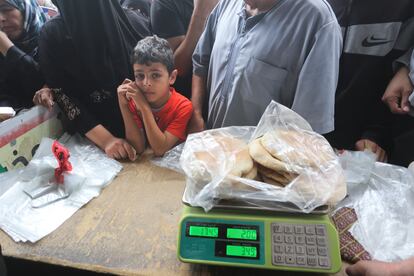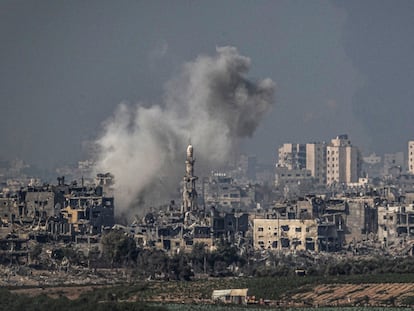Thousands loot UN aid warehouses in Gaza as desperation grows and Israel widens ground offensive
Tanks and infantry pushed into Gaza over the weekend as Israeli Prime Minister Benjamin Netanyahu announced a ‘second stage’ in the war

Thousands of people broke into aid warehouses in Gaza to take flour and basic hygiene products, a U.N. agency said Sunday, in a mark of growing desperation and the breakdown of public order three weeks into the war between Israel and Gaza’s militant Hamas rulers.
Tanks and infantry pushed into Gaza over the weekend as Israeli Prime Minister Benjamin Netanyahu announced a “second stage” in the war, three weeks after Hamas launched a brutal incursion into Israel. The widening ground offensive came as Israel pounded the territory from air, land and sea.
The bombardment — described by Gaza residents as the most intense of the war — knocked out most communications in the territory late Friday, largely cutting off the besieged enclave’s 2.3 million people from the world. Communications were restored to much of Gaza early Sunday.
The U.N. agency for Palestinian refugees, known as UNRWA, provides basic services to hundreds of thousands of people in Gaza. Its schools across the territory have been transformed into packed shelters housing Palestinians displaced by the conflict. Israel has allowed only a small trickle of aid to enter from Egypt, some of which was stored in one of the warehouses that was broken into, UNRWA said.
Thomas White, the agency’s Gaza director, said the break-ins were “a worrying sign that civil order is starting to break down after three weeks of war and a tight siege on Gaza. People are scared, frustrated and desperate,” he said.
Juliette Touma, a spokesperson for the agency, said the crowds broke into four facilities on Saturday. She said the warehouses did not contain any fuel, which has been in critically short supply since Israel cut off all shipments after the start of the war.
Residents living near Shifa Hospital, Gaza’s largest, meanwhile said Israeli airstrikes overnight Sunday hit near the hospital complex and blocked many roads leading to it. Israel accuses Hamas of having a secret command post beneath the hospital, without providing much evidence.
Tens of thousands of civilians are sheltering in Shifa, which is also packed with patients wounded in the strikes.
“Reaching the hospital has become increasingly difficult,” Mahmoud al-Sawah, who is sheltering in the hospital, said over the phone. “It seems they want to cut off the area.” Another Gaza City resident, Abdallah Sayed, said the Israeli bombing over the past two days was “the most violent and intense” since the war started.
Israel says most residents have heeded its orders to flee to the south, but hundreds of thousands remain in the north, in part because Israel has also bombarded targets in so-called safe zones.
An Israeli airstrike hit a two-story house in the southern city of Khan Younis on Sunday, killing at least 13 people, including 10 from one family. The bodies were brought to the nearby Nasser Hospital, according to an Associated Press journalist at the scene.
The Israeli military had no immediate comment when asked about reports of strikes near Shifa. The army said it had struck over 450 militant targets over the last 24 hours, including Hamas command centers, observation posts and anti-tank missile launching positions.
The military also said more forces were sent into Gaza overnight.
The army recently released computer-generated images showing what it said were Hamas installations in and around Shifa Hospital, as well as interrogations of captured Hamas fighters who might have been speaking under duress. Israel has made similar claims before, but has not substantiated them.
Little is known about Hamas’ tunnels and other infrastructure, and the claims could not be independently verified. Hamas’ government dismissed the allegations as “lies” and said they were “a precursor for striking this facility.”
The escalation ratcheted up domestic pressure on Israel’s government to secure the release of some 230 hostages seized in the Oct. 7 rampage, when Hamas fighters from Gaza breached Israel’s defenses and stormed into nearby towns, gunning down civilians and soldiers in a surprise attack.
Desperate family members met with Netanyahu on Saturday and expressed support for an exchange for Palestinian prisoners held in Israel.
Hamas’ top leader in Gaza, Yehia Sinwar, said Palestinian militants “are ready immediately” to release all hostages if Israel releases all of the thousands of Palestinians held in its prisons. Rear Adm. Daniel Hagari, an Israeli military spokesman, dismissed the offer as “psychological terror.”
Netanyahu told the nationally televised news conference that Israel is determined to bring back all the hostages, and maintained that the expanding ground operation “will help us in this mission.” He said he couldn’t reveal everything that is being done due to the sensitivity and secrecy of the efforts.
“This is the second stage of the war, whose objectives are clear: to destroy the military and governmental capabilities of Hamas and bring the hostages home,” he said in his first time taking questions from journalists since the war began.
Netanyahu also acknowledged that the Oct. 7 “debacle,” in which more than 1,400 people were killed, would need a thorough investigation, adding that “everyone will have to answer questions, including me.”
The Israeli military said it was gradually expanding its ground operations inside Gaza, while stopping short of calling it an all-out invasion. Casualties on both sides are expected to rise sharply as Israeli forces and Palestinian militants battle in dense residential areas.
Despite the Israeli offensive, Palestinian militants have continued firing rockets into Israel, with the constant sirens in southern Israel a reminder of the threat.
The Palestinian death toll in Gaza rose Saturday to just over 7,700 people since the war began, with 377 deaths reported since late Friday, according to the Gaza Health Ministry. Most of those killed have been women and minors, the ministry said.
An estimated 1,700 people remain trapped beneath the rubble, according to the Health Ministry, which has said it bases its estimates on distress calls it received.
Israel says its strikes target Hamas fighters and infrastructure and that the militants operate among civilians, putting them in danger.
More than 1.4 million people across Gaza have fled their homes, nearly half crowding into U.N. schools and shelters, following repeated warnings by the Israeli military that they would be in danger if they remained in northern Gaza.
Gaza’s sole power plant shut down shortly after the start of the war, and Israel has allowed no fuel to enter, saying Hamas would use it for military purposes.
Hospitals are struggling to keep emergency generators running to operate incubators and other life-saving equipment, and the U.N. agency for Palestinian refugees is also trying to keep water pumps and bakeries running to meet essential needs.
Sign up for our weekly newsletter to get more English-language news coverage from EL PAÍS USA Edition
Tu suscripción se está usando en otro dispositivo
¿Quieres añadir otro usuario a tu suscripción?
Si continúas leyendo en este dispositivo, no se podrá leer en el otro.
FlechaTu suscripción se está usando en otro dispositivo y solo puedes acceder a EL PAÍS desde un dispositivo a la vez.
Si quieres compartir tu cuenta, cambia tu suscripción a la modalidad Premium, así podrás añadir otro usuario. Cada uno accederá con su propia cuenta de email, lo que os permitirá personalizar vuestra experiencia en EL PAÍS.
¿Tienes una suscripción de empresa? Accede aquí para contratar más cuentas.
En el caso de no saber quién está usando tu cuenta, te recomendamos cambiar tu contraseña aquí.
Si decides continuar compartiendo tu cuenta, este mensaje se mostrará en tu dispositivo y en el de la otra persona que está usando tu cuenta de forma indefinida, afectando a tu experiencia de lectura. Puedes consultar aquí los términos y condiciones de la suscripción digital.
More information
Archived In
Últimas noticias
Trump claims peace in Ukraine is near, but Moscow suggests otherwise
A survivor’s account of the Interoceanic Train accident: ‘We were scared because of the speed on the curve’
The Interoceanic Train, the Mexican alternative to the Panama Canal
What is known about the Interoceanic Train derailment in Oaxaca
Most viewed
- Oona Chaplin: ‘I told James Cameron that I was living in a treehouse and starting a permaculture project with a friend’
- Reinhard Genzel, Nobel laureate in physics: ‘One-minute videos will never give you the truth’
- Why the price of coffee has skyrocketed: from Brazilian plantations to specialty coffee houses
- Pablo Escobar’s hippos: A serious environmental problem, 40 years on
- Chevy Chase, the beloved comedian who was a monster off camera: ‘Not everyone hated him, just the people who’ve worked with him’










































